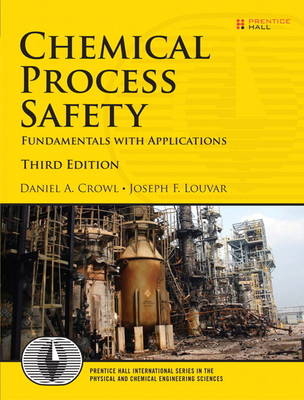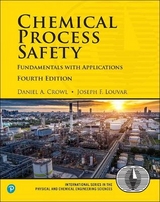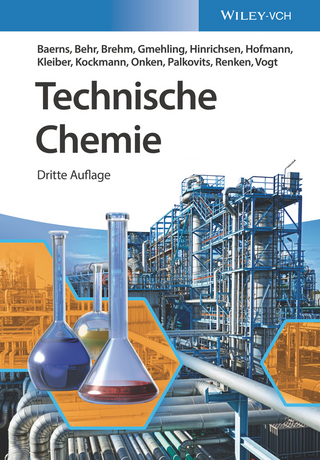
Chemical Process Safety
Pearson (Verlag)
978-0-13-138226-8 (ISBN)
- Titel erscheint in neuer Auflage
- Artikel merken
As chemical processes have grown more complex, so have the safety systems required to prevent accidents. Chemical Process Safety, Third Edition, offers students and practitioners a more fundamental understanding of safety and the application required to safely design and manage today’s sophisticated processes.
The third edition continues the definitive standard of the previous editions. The content has been extensively updated to today’s techniques and procedures, and two new chapters have been added. A new chapter on chemical reactivity provides the information necessary to identify, characterize, control, and manage reactive chemical hazards. A new chapter on safety procedures and designs includes new content on safely management, and specific procedures including hot work permits, lock-tag-try, and vessel entry.
Subjects Include
Inherently safer design
Toxicology and industrial hygiene
Toxic release and dispersion models
Fires and explosions, and how to prevent them
Reliefs and relief sizing
Hazard identification
Risk assessment
Safe designs and procedures
Case histories
Chemical Process Safety, Third Edition, is an ideal reference for professionals. It can be used for both graduate and undergraduate instruction. This edition contains more than 480 end-of-chapter problems. A solutions manual is available for instructors.
Daniel A. Crowl is Herbert H. Dow Professor for Chemical Process Safety at Michigan Tech. He serves on the AIChE Center for Chemical Process Safety (CCPS) Safety and Chemical Engineering Education (SACHE) Committee, and is author/editor of several AIChE books on process safety. His awards include AIChE’s Bill Doyle Award; the ACS Chemical Health and Safety Award; the Walton/Miller award from AIChE’s Safety and Health Division; and the AIChE Board’s Gary Leach Award. He is a Fellow of AIChE, ACS Safety and Health Division , and CCPS. Joseph F. Louvar is Research Professor at Wayne State University’s College of Engineering, where he teaches chemical process safety, risk assessment, and process design. He was recently the CCPS staff consultant for the Undergraduate Education Committee, commonly known as the Safety and Chemical Engineering Education Committee (AIChE’s SACHE) and has previously chaired this committee for over ten years. His books include Health and Environmental Risk Analysis: Fundamentals with Applications (Prentice Hall, 1997).
Preface xv About the Authors xvii
On the Cover xviii
Nomenclature xix
Chapter 1: Introduction 1
1-1 Safety Programs 2
1-2 Engineering Ethics 4
1-3 Accident and Loss Statistics 4
1-4 Acceptable Risk 12
1-5 Public Perceptions 14
1-6 The Nature of the Accident Process 15
1-7 Inherent Safety 20
1-8 Seven Significant Disasters 23
Suggested Reading 31
Problems 32
Chapter 2: Toxicology 37
2-1 How Toxicants Enter Biological Organisms 38
2-2 How Toxicants Are Eliminated from Biological Organisms 41
2-3 Effects of Toxicants on Biological Organisms 42
2-4 Toxicological Studies 43
2-5 Dose versus Response 44
2-6 Models for Dose and Response Curves 50
2-7 Relative Toxicity 56
2-8 Threshold Limit Values 56
2-9 National Fire Protection Association (NFPA) Diamond 58
On-Line Resources 59
Suggested Reading 60
Problems 60
Chapter 3: Industrial Hygiene 65
3-1 Government Regulations 66
3-2 Industrial Hygiene: Anticipation and Identification 78
3-3 Industrial Hygiene: Evaluation 84
3-4 Industrial Hygiene: Control 99
On-Line Resources 109
Suggested Reading 109
Problems 110
Chapter 4: Source Models 119
4-1 Introduction to Source Models 119
4-2 Flow of Liquid through a Hole 122
4-3 Flow of Liquid through a Hole in a Tank 126
4-4 Flow of Liquids through Pipes 131
4-5 Flow of Gases or Vapors through Holes 140
4-6 Flow of Gases or Vapors through Pipes 146
4-7 Flashing Liquids 163
4-8 Liquid Pool Evaporation or Boiling 169
4-9 Realistic and Worst-Case Releases 170
4-10 Conservative Analysis 172
Suggested Reading 173
Problems 174
Chapter 5: Toxic Release and Dispersion Models 185
5-1 Parameters Affecting Dispersion 186
5-2 Neutrally Buoyant Dispersion Models 190
5-3 Dense Gas Dispersion 209
5-4 Dense Gas Transition to Neutrally Buoyant Gas 219
5-5 Toxic Effect Criteria 225
5-6 Effect of Release Momentum and Buoyancy 233
5-7 Release Mitigation 234
Suggested Reading 235
Problems 236
Chapter 6: Fires and Explosions 245
6-1 The Fire Triangle 245
6-2 Distinction between Fires and Explosions 247
6-3 Definitions 247
6-4 Flammability Characteristics of Liquids and Vapors 249
6-5 Limiting Oxygen Concentration and Inerting 260
6-6 Flammability Diagram 262
6-7 Ignition Energy 270
6-8 Autoignition 270
6-9 Auto-Oxidation 271
6-10 Adiabatic Compression 272
6-11 Ignition Sources 273
6-12 Sprays and Mists 274
6-13 Explosions 275
Suggested Reading 304
Problems 305
Chapter 7: Concepts to Prevent Fires and Explosions 317
7-1 Inerting 318
7-2 Static Electricity 333
7-3 Controlling Static Electricity 356
7-4 Explosion-Proof Equipment and Instruments 363
7-5 Ventilation 367
7-6 Sprinkler Systems 370
7-7 Miscellaneous Concepts for Preventing Fires and Explosions 374
Suggested Reading 374
Problems 375
Chapter 8: Chemical Reactivity 381
8-1 Background Understanding 382
8-2 Commitment,Awareness, and Identification of Reactive Chemical Hazards 384
8-3 Characterization of Reactive Chemical Hazards Using Calorimeters 390
8-4 Controlling Reactive Hazards 416
Suggested Reading 418
Problems 418
Chapter 9: Introduction to Reliefs 429
9-1 Relief Concepts 430
9-2 Definitions 432
9-3 Location of Reliefs 433
9-4 Relief Types and Characteristics 436
9-5 Relief Scenarios 443
9-6 Data for Sizing Reliefs 444
9-7 Relief Systems 444
Suggested Reading 452
Problems 453
Chapter 10: Relief Sizing 459
10-1 Conventional Spring-Operated Reliefs in Liquid Service 460
10-2 Conventional Spring-Operated Reliefs in Vapor or Gas Service 466
10-3 Rupture Disc Reliefs in Liquid Service 470
10-4 Rupture Disc Reliefs in Vapor or Gas Service 471
10-5 Two-Phase Flow during Runaway Reaction Relief 472
10-6 Pilot-Operated and Bucking-Pin Reliefs 481
10-7 Deflagration Venting for Dust and Vapor Explosions 481
10-8 Venting for Fires External to Process Vessels 488
10-9 Reliefs for Thermal Expansion of Process Fluids 492
Suggested Reading 496
Problems 497
Chapter 11: Hazards Identification 505
11-1 Process Hazards Checklists 508
11-2 Hazards Surveys 508
11-3 Hazards and Operability Studies 524
11-4 Safety Reviews 530
11-5 Other Methods 537
Suggested Reading 538
Problems 538
Chapter 12: Risk Assessment 549
12-1 Review of Probability Theory 550
12-2 Event Trees 564
12-3 Fault Trees 569
12-4 QRA and LOPA 577
Suggested Reading 588
Problems 588
Chapter 13: Safety Procedures and Designs 597
13-1 Process Safety Hierarchy 598
13-2 Managing Safety 599
13-3 Best Practices 600
13-4 Procedures–Operating 600
13-5 Procedures–Permits 601
13-6 Procedures–Safety Reviews and Accident Investigations 603
13-7 Designs for Process Safety 604
13-8 Miscellaneous Designs for Fires and Explosions 615
13-9 Designs for Runaway Reactions 615
13-10 Designs for Handling Dusts 616
Suggested Reading 617
Problems 618
Chapter 14: Case Histories 621
14-1 Static Electricity 622
14-2 Chemical Reactivity 626
14-3 System Designs 631
14-4 Procedures 637
14-5 Training 642
14-6 Conclusion 645
Suggested Reading 646
Problems 646
Appendix A: Unit Conversion Constants 649
Appendix B: Flammability Data for Selected Hydrocarbons 653
Appendix C: Detailed Equations for Flammability Diagrams 659
Equations Useful for Gas Mixtures 659
Equations Useful for Placing Vessels into and out of Service 664
Appendix D: Formal Safety Review Report for Example 10-4 669
Appendix E: Saturation Vapor Pressure Data 679
Appendix F: Special Types of Reactive Chemicals 681
Appendix G: Hazardous Chemicals Data for a Variety of Chemical Substances 687
Index 695
| Reihe/Serie | International Series in the Physical and Chemical Engineering Sciences |
|---|---|
| Sprache | englisch |
| Maße | 185 x 235 mm |
| Gewicht | 1359 g |
| Themenwelt | Naturwissenschaften ► Chemie ► Technische Chemie |
| Technik ► Umwelttechnik / Biotechnologie | |
| ISBN-10 | 0-13-138226-8 / 0131382268 |
| ISBN-13 | 978-0-13-138226-8 / 9780131382268 |
| Zustand | Neuware |
| Informationen gemäß Produktsicherheitsverordnung (GPSR) | |
| Haben Sie eine Frage zum Produkt? |
aus dem Bereich



